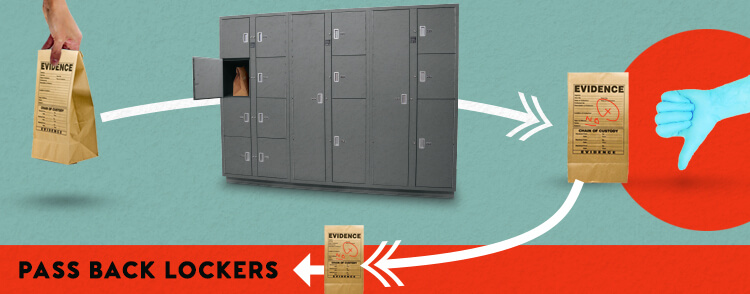CHALLENGER INSIGHTS Vol. 18:
Pass Back Evidence Compartments

“Gary, can Spacesaver make an ED3 evidence locker with a compartment that has a digital lock for ‘crash storage’ or pass back applications?” I’ve been hearing this question more and more lately, and I like it for a few reasons. This question tells me we are talking to the users, we are talking about applications, and we are designing a solution, all of which bring value to our customers. Good work team!
With more and more departments requesting pass back lockers, it’s important to know how to meet their need. While Spacesaver doesn’t offer them as a standard product offering, we can easily design pass back lockers using currently available locker options. I’ll show you how.
What’s a Pass Back Locker?
First things first – it’s important to understand whether the agency you’re working with is looking for pass back storage or a crash locker. A Pass Back Locker is used when evidence is returned to an officer. If an evidence technician retrieves evidence from a locker and finds that the officer packaged or labeled the evidence incorrectly, they need a way to return it to the officer to repackage then return.
Alternatively, the officer may be taking the evidence to a crime lab or court. Either way, the technician needs a way to return the evidence to the officer while preserving the chain of custody – meaning only the technician and the officer should have access to the evidence.
What’s a Crash Mode Locker?
Crash mode is an urgent call to duty, and it means that officers must drop everything and respond. If an officer is busy processing or packaging evidence when an urgent call arrives, they won’t have time to process or package the evidence. Crash mode lockers provide a secure place for an officer to quickly deposit evidence until they can return to finish packaging it.
So how do I design one of these?
Many agencies currently use an old school-type locker for pass back functionality, but pass back and crash lockers can easily be incorporated into a bank of evidence lockers for added convenience and security.
If the department is using Non-Pass-Thru Evidence Lockers, ensure that Spacesaver keys each compartment differently, and ensure that a set of keys for each compartment is provided with at least one master key. The master key will go to the evidence technician. The compartment key can then be issued to the officer collecting the pass back evidence, who can return the key after retrieving the evidence.
With a Pass-Thru locker, at least one locker compartment (the compartment designated for pass back) must include a digital lock. This process will involve an ETO (Engineered To Order), but it can be added. The digital lock should be programmed with a PIN for each use with a master key override. An evidence technician can assign a PIN to the officer who is retrieving the evidence. For crash locker use, the digital programmable PIN lock would allow the officer to deposit evidence and retrieve the evidence after the call while preserving the chain of custody.
We should be talking to end users and discussing Crash, Pass Back, and Pass Thru applications. This solution can make a big difference for the evidence technicians and the department. Have you installed this solution? Have a photo you can share?
Email McKenna Dustman at mdustman@spacesaver.com to share your thoughts and questions.